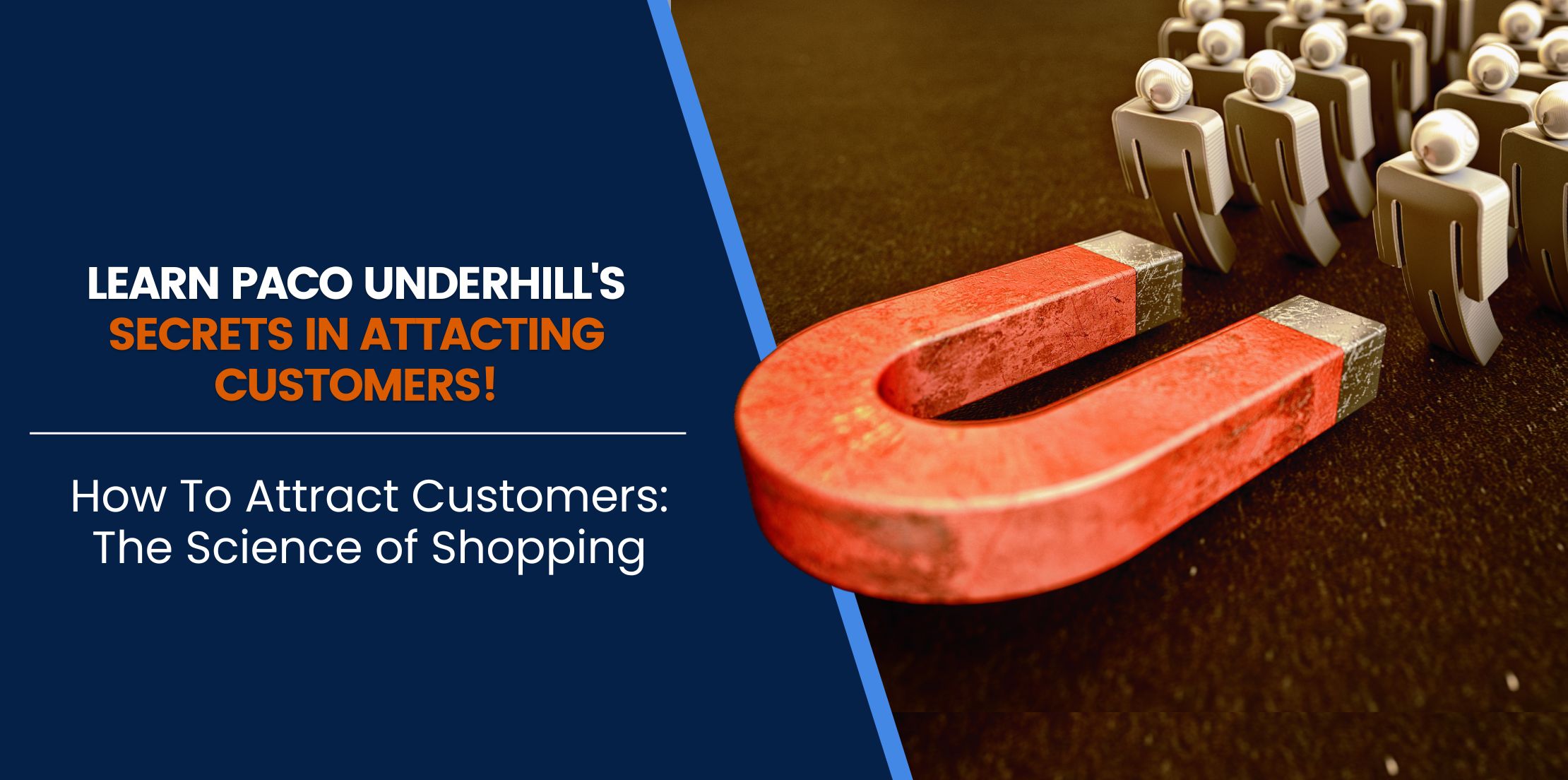Business owners are plagued with one thought in mind: how do I get more sales?
Certainly, you’ve had those days when you contemplate and strategize how you’ll skyrocket your revenue through sales. The thing is, selling is a function of attracting. Therefore, you have to learn how to attract customers first before making a sale.
Knowing how to sell and understanding what it takes to attract customers are two different things. While they are not mutually exclusive, they are interdependent.
How?
Making a sale is easier when you’re dealing with relational buyers. On the other hand, having a appealing sales pitch is a powerful magnet you can use to attract customers.
Like a nectar-filled flower that entices a bee, how do you make your business attractive to consumers? We’ll get to that later.
Among the thought leaders in consumer behavior, Paco Underhill did his due diligence to uncover the science of shopping. In his book, “Why Do We Buy,” he shares precious nuggets and tips on how to attract customers. The New Yorker’s 1996 issue by Malcolm Gladwell builds on Underhill’s research and also shares insights into this plight.
Let’s explore how to attract customers and how you could do it in your business.
 The Science of Shopping
The Science of Shopping
Paco Underhill is one of the world’s leading authorities on consumer behavior. He and his company embarked on a quest to understand the market’s age-old question: why do we buy? In 1999, he transcribed and published his research into the book “Why We Buy: The Science of Shopping.”
From the theme of his writing, attracting customers is all about creating an environment that appeals to the senses. When everything about your business hits the right spot in a customer’s preferences, they will inevitably be attracted. This includes factors such as lighting, scent, and even music. He emphasizes the importance of also considering things like store layout and signage to guide shoppers toward desirable products.
A portion of his writings also pointed to the importance of understanding your market’s demographics. This suggests that in order to attract customers, you need to first understand who your target market is. Only then will you manage to cater to their specific needs and preferences. Market research and customer feedback aid in this front and help your business attract a loyal base of shoppers.
The only caveat in his study is that Underhill focused on retail stores. You may wonder, “what does retail have to do with my residential home service business?” Despite the limitations of his studies, the principles remain universally true. Here, we’ll uncover his discoveries and relate them to the home services industry.
If you’re looking for business strategists who can help you attract customers – the best kinds of them – we can help. Wizard of Sales® has helped out other businesses create a positive sales experience that leaves customers wanting more. Utilizing the principles outlined by Underhill, we can help attract and maintain your ideal customers. All it takes is booking a call.
How Do Businesses Attract Customers?
Sadly, attracting customers is not a strong suit for many businesses and there are known culprits behind this predicament.
One of the main reasons why businesses fail to attract customers is a lack of understanding of their target audience. Without properly identifying who their potential customers are, businesses struggle to create products that appeal to them. Being familiar with your market means knowing their problems and finding a corresponding solution. Moreover, it’s crucial to meet their underlying felt needs (money, energy, and time) that surround their problems.
No matter who you hire to market or advertise your products, they will never mask an unfit solution. Conducting market analysis resolves this misaligned product-market fitness or the appropriateness of the solution to the problem.
Failure to adapt to market trends can also deter customers from choosing a particular business. One example of this is misaligned product-channel fitness or using unsuitable mediums in advertising your solutions. For instance, advertising through the yellow pages makes no sense in 2022. You have to take advantage of newer mediums like digital marketing and stick with sensible traditional marketing channels.
Pricing is another aspect you want to consider if you aim to attract customers with your solutions. I’m not saying to cheap out on solutions, but you must consider the sensibility of your costs. Does the value justify the asking price? What makes your solutions better considering your competition sells for cheaper?
A relatively pricier offering is okay as long as the value makes up for it. The key here is finding your perfectly fair competitive advantage or the offer that outweighs your competition despite the higher cost.
In today’s competitive marketplace, it’s important for businesses to continuously strive to attract and retain customers. Here, we’ll look at how to attract customers through Paco Underhill’s book. Let’s explore them below.
 Paco Underhill’s Observation and Theories
Paco Underhill’s Observation and Theories
Before we delve into Paco Underhill’s theories, we should make something clear.
Paco Underhill’s writing primarily focuses on retail stores and not other business models like home services. While buying habits are generally the same across cultures, we must take his concepts with a grain of salt. The list below features how I reconciled his research and applied the principles in the residential home services industry.
Note: Some may apply to your business, and others may not. It’s best to view your company in perspective as you read along. This will enable you to maximize the value and application you may implement. Hiring business strategists like Wizard of Sales® is the best way to ensure you’re on the right track.
That said, here are his principles:
The Decompression Zone
One of the most peculiar aspects discussed by Paco Underhill in his book is the concept of the decompression zone.
The decompression zone is the physical space about 15 feet from the entrance of the store. He referred to it as such because it is where customers relax as they enter the store. It’s a place where customers take a moment to gather their thoughts before they begin the shopping experience. All of these processes occur as customers walk from the entrance to the aisles.
If we are to attract customers, he argued, we should never put anything of value within the decompression zone. Customers’ thoughts are preoccupied so they’ll need to concentrate first before shopping. Any valuable product in the area will only be blocked out by your customers. He recommends keeping your flagship solutions beyond the decompression zone so buyers see them once they’re ready to shop.
How does this relate to residential home services?
If you have a physical store, the application is straightforward. Don’t put your world-class HVAC unit or your premium roof shingles up front. You want customers to decompress first before they see your solutions. The same principle applies to online stores.
Don’t bombard customers with your products the moment they visit your website. Use the landing page to reel your customers slowly into the shopping experience. Think of your landing page as the decompression zone to prepare customers for your solution.
The question is: What content do you present on your landing page that gets your visitors glued to the screen?
Make your landing page a decompression zone that keeps customers on your website. Here are some ways you can do this:
- Improve your landing page aesthetics
- Write persuasive and captivating copy
- Make sure your menu buttons and navigational tools are clear
Doing these things will lead customers to where you want them to be – your products and services.
The Invariant Right
The concept of the “invariant right” is another Paco Underhill theory in retail shopping. He argues that customers have an innate desire to turn to the right when entering a store. When customers enter the store, they scan the items from left to right. He calls this the invariant right because it’s the invariable default among shoppers.
Taking this into account, retail stores can then position popular or eye-catching items on the right side of the store. If the theory checks out, more customers will be attracted which leads to increased sales.
The application of this theory for residential home services is also straightforward. If you have physical stores, you may try to implement the same strategy. There is also merit in the invariant right theory for online stores and websites.
Think about it. Did you notice that most websites often have a mini dashboard on the left while the right focuses on content? Look at Facebook, Twitter, YouTube and other websites. They all warrant the invariant right.
Why?
Gladwell says the invariant right is also a representation of our brain function:
- The left brain absorbs and processes data
- The right brain assimilates the interpretation and then uses it to make decisions
Keeping your most important products and services on the right pane is the best application of this theory. Subconsciously, your visitors may check them out and buy.
The Butt-brush
One striking theory that Underhill discusses in “Why We Buy” is the concept of the “butt-brush.”
He used women as the principal example for this theory. He says women dislike it when people brush against their buttocks. In stores, this could happen when they’re busy examining a product and someone passes behind them. This often happens in narrow aisles, and if women experience this, they will subconsciously avoid that aisle.
Paco’s application was unique as he suggested not to display products that need reviewing in narrow aisles. These aisles, he says, are dedicated to things that are quick to grab. Why? Because narrow aisles incite impulsive behavior among shoppers.
Sadly, there’s no room for compulsion when you’re a residential home service provider. Customers want to be sure of what they’re getting into and providers try their best to guide them.
Now then, how does this theory apply to residential home services?
- For physical stores — avoid a cluttered entryway or a cramped product-viewing space. This may deter potential clients from wanting to hire your services. Instead, create an open and inviting area where customers can view, inquire, test and appreciate your solutions.
- For online stores — steer clear of cramping your webpage with multiple solutions at once as this can be overwhelming. Let your customers breeze through your listing freely so they can analyze your solutions comfortably.
Petting
According to Paco Underhill, one way to attract customers is by letting them physically touch their merchandise before buying. He calls this process “petting.”
Try to think about it, when was the last time you entered a store and you didn’t touch any product? Exactly. Petting is engraved in our system– it increases product value and stirs the brain to buy the item we’re touching.
Of course, petting is an utter impossibility if we talk about online stores. However, for residential home service businesses with physical shops, this theory holds true.
It’s helpful to keep stock of your solutions in store to gratify the petting nature of your buyers. For example, if you’re a plumber keep your sinks and water fixtures in sight. Roofers, on the other hand, must have samples of their shingles available for petting.
All of Paco Underhill’s theories on how to attract customers are based on years and years of observation. The publication and wide reception of his book speak layers about the reality of his concepts. Although, we must keep in mind that his focus was on retail stores. That means you may observe differences in the application with other industries like residential home services.
Nonetheless, strengthening all touchpoints of your business is still the best way to truly attract your customers. Your culture, products, online assets, sales team, and customer service must all be excellent. Doing so ensures that you leave a positive shopping experience and attract customers to seek your services.
If you’re looking for a business strategist to create surefire tactics that attract customers, we can help. Book a call with Wizard of Sales® and let’s make your business stand 600 ft. above the competition.


 The Science of Shopping
The Science of Shopping Paco Underhill’s Observation and Theories
Paco Underhill’s Observation and Theories